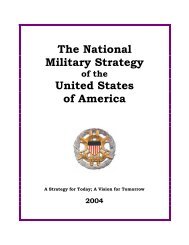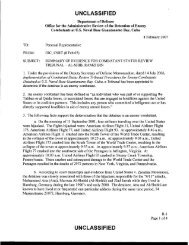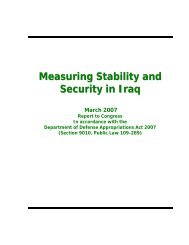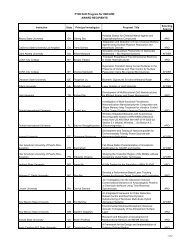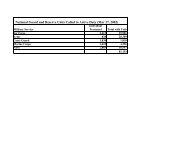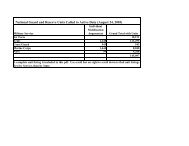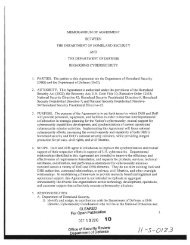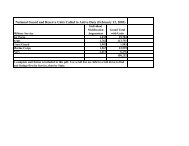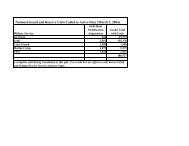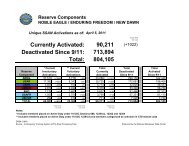Report - United States Department of Defense
Report - United States Department of Defense
Report - United States Department of Defense
You also want an ePaper? Increase the reach of your titles
YUMPU automatically turns print PDFs into web optimized ePapers that Google loves.
UNCLASSIFIED<br />
to be exclusively run by IDLG and allow the Afghan government to take full funding<br />
responsibility gradually. USAID will likely not engage in this on-budget program. Currently,<br />
USAID is conducting a broader revision process, clarifying its engagement for the future.<br />
USAID’s future provincial level program will provide capacity building support to Provincial<br />
Governors and Provincial Councils efforts in targeted provinces.<br />
Afghanistan Sub-national Governance Program (ASGP). In 2012 (SY1391), the ASGP<br />
budget was $20M and was funded by Australia, the European Union (EU), Italy, Japan,<br />
Switzerland, Sweden, and the UNDP. The program supports Afghan government efforts to<br />
implement its sub-national governance reform agenda through its main national partner, IDLG,<br />
and a network <strong>of</strong> Provincial Governors Offices (PGOs), District Governors Offices (DGOs),<br />
Provincial Councils (PCs) and municipalities. ASGPII will continue working with PGOs,<br />
concentrating efforts at the provincial level and implementing its programs at the district level as<br />
they become accessible and the Afghan government develops the capacity to absorb donor<br />
assistance. The upcoming ASGPIII (post 2014) will furthermore push the DGO’s role with<br />
regard to planning capacity. Local responsibility for planning and budgeting, transparent<br />
accountability mechanisms, and improved oversight by elected councils over provincial, district,<br />
and municipal administrations are imperative. The complete integration <strong>of</strong> ASGP with the NPP<br />
4 is an urgent priority for the Afghan government.<br />
Regional Afghan Municipal Program for Urban Population (RAMP-UP). This is a USAIDfunded<br />
program established to assist major Afghan urban centers (currently all the provincial<br />
centers plus Kabul) and improve their ability to fund service-delivery projects. Funding for the<br />
sequel program, “RAMP-UP 2,” in 2014 and beyond will likely be reduced to $50M over five<br />
years, down from $80M for the current program. Due to these budget reductions, municipalities<br />
eligible for “RAMP-UP 2” must be carefully selected using a scoring system that allows USAID<br />
to judge performance indicators (e.g., transparency, good governance, budget, etc.). With<br />
significant population growth in urban centers expected to continue, RAMP-UP will be an<br />
important mechanism to help organize service delivery for an increasingly high percentage <strong>of</strong> the<br />
Afghan population. This program will enable the municipalities as they become increasingly<br />
responsible for providing security and services that facilitate and promote economic growth.<br />
These programs help to strengthen the link between the national and sub-national levels, but until<br />
councils and committees begin to improve the delivery <strong>of</strong> basic services, the people in the<br />
districts and villages will see a limited connection to the national government. Over time, and if<br />
properly coupled with the TMAF commitments, the programs noted above aim to increase the<br />
levels <strong>of</strong> delegation, accountability, and effectiveness at sub-national level, particularly in areas<br />
<strong>of</strong> budget planning and execution. The TMAF seeks to enhance sub-national governance<br />
through three specific indicators:<br />
i. Improve budget execution to 75 percent by 2017.<br />
ii. Enact a legal framework to clarify roles and responsibilities <strong>of</strong> government agencies at<br />
national, provincial, and district levels, in line with 2010 sub-national governance policy.<br />
iii. Develop a provincial budgeting process that includes provincial input to the relevant<br />
ministries’ formulation <strong>of</strong> budget requests, linked to a provincial planning process, in which<br />
provincial councils have consultative roles.<br />
131



